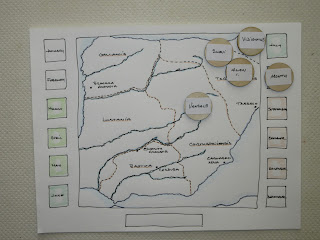An Assessment
The most important change from the initial test of Sub
Roman Britain to that of Hispania was how best to reconcile the passage of
time. This was solved by changing the value of the card drawn to read the
number of ‘months’ in place of ‘years’. This ensured that key events would have
relevance in the game and not be quickly passed over.
Assigning a suite to represent the principle barbarian
nations was easily done. The fourth suite was reserved for ‘Rome’ and later the
local government officials or senators. The eventual split of the Vandals to the
Asding and Siling was solved using the same suite, but an odd or even card drawn
would allow that tribal group take action.
The cast of one die to determine the attacker/defender
remained as did the method to determine the terrain to be used. In the seven
major engagements, five were fought on arable ground, one in hilly terrain and
one in a forest region.
Battles between full size armies did take place, but
this was rare. The rebellion in Gallicia had six elements per side turned out
to be a very enjoyable game. The same die cast used to determine the
attacker/defender role and terrain also resolved the replenishment of troops
for the battle. Unfortunately, the successive defeats by the Suevi meant repeatedly
meeting the enemy with an inferior force.
The game comfortably moved through two decades of play
taking two days to play. To reach 429 AD, 37 cards were drawn to initiate
tribal or Roman activity. Key historical events did fall into place if not by
their exact month, then certainly by their correct year.
After the death of Maximus, central authority in
Hispania disappears leaving local senators to negotiate directly with the
various tribes. The value of the card drawn (club) determined if this was
successful or not.
I am pleased with the rule set reaching a near
historical result. The Vandals and Alani did make their crossing to Africa on
time. It remains to be seen if the Suevi could create their empire in Hispania
given the weakened state of their army.
Next planned tests will bring my newly painted armies
to the table. Each of the armies will be presented with a brief history, their painting
and photos. This will give me the necessary time to design a map and write a
scenario for the third campaign.
Cheers,











































